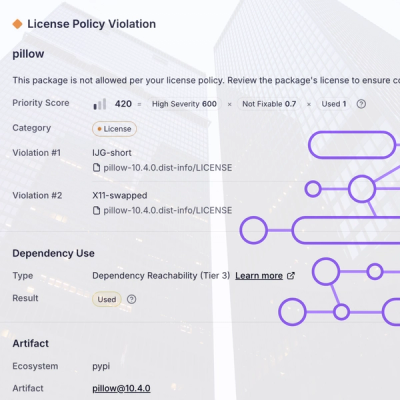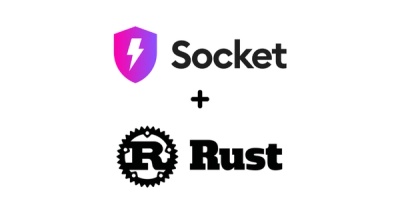
Research
/Security News
Critical Vulnerability in NestJS Devtools: Localhost RCE via Sandbox Escape
A flawed sandbox in @nestjs/devtools-integration lets attackers run code on your machine via CSRF, leading to full Remote Code Execution (RCE).
.. image:: https://travis-ci.org/timeoutdigital/treehugger.svg?branch=master :target: https://travis-ci.org/timeoutdigital/treehugger
Takes care of your environment (variables) on AWS.
setup.py - boto3, PyYAML,
requests, and six.alias/treehugger.Treehugger lets you use KMS <https://aws.amazon.com/kms/>_ encrypted environment variables to run your application on
EC2. You store the encrypted variables in YAML files alongside your other configuration management, then just get them
into the EC2 User Data for an instance. Treehugger can read the variables from user data, decrypt the encrypted ones,
and run your application.
For example, say we want to run an application that takes a GITHUB_TOKEN environment variable for talking to
GitHub. Since this is sensitive data, we want to store it encrypted and only decrypt it when running the application.
You can start by writing a YAML file my_app_vars.yml that contains the variable in its unencrypted form, in a
to_encrypt key in a mapping that indicates it should be encrypted:
.. code-block:: yaml
GITHUB_TOKEN: {to_encrypt: example-token}
TREEHUGGER_APP: my-app
TREEHUGGER_STAGE: prod
The TREEHUGGER_APP and TREEHUGGER_STAGE variables are mandatory and used to provide context to Treehugger. They
are used to encrypt the variables using KMS's Encryption Context <https://docs.aws.amazon.com/kms/latest/developerguide/encryption-context.html>_ feature, giving access control and
protection against tampering.
You can encrypt the file by running:
.. code-block:: sh
treehugger encrypt-file my_app_vars.yml
It'll be changed to something like:
.. code-block:: yaml
GITHUB_TOKEN: {encrypted: AQECAHiVqEdWu6BhwWXkqJrEhgPpuDXA3TC1MPUeQb...}
TREEHUGGER_APP: my-app
TREEHUGGER_STAGE: prod
Note that the plaintext variables are not encrypted, only those marked to_encrypt.
Going forwards you can edit the file with:
.. code-block:: sh
treehugger edit my_app_vars.yml
This will decrypt the file into a temporary file, open that in your $EDITOR, then once that finishes encrypt it
back in place. This avoids any risk of accidentally committing your decrypted secrets.
For deployment, it's up to you to get the contents of that file into the User Data <https://docs.aws.amazon.com/AWSEC2/latest/UserGuide/ec2-instance-metadata.html>_ of the EC2 instance of the
application, underneath the key treehugger.
For example, you could pass the contents of the file as a parameter to a CloudFormation template that puts the value
into the UserData property of an AutoScaling Group. For example if passed in as a parameter TreehuggerUserData
(with extra indentation):
.. code-block:: yaml
LaunchConfig:
Type: AWS::AutoScaling::LaunchConfiguration
Properties:
UserData:
Fn::Base64:
!Sub
- |
treehugger:
${IndentedTreehuggerUserData}
Then on the EC2 instance your application can be started with:
.. code-block:: sh
treehugger exec -- /path/to/application
Treehugger will load the User Data as YAML, extract the dictionary under the 'treehugger' key, decrypt the variables
marked encrypted, put them into the environment, and then replace itself with a copy of the application using
execlp <https://linux.die.net/man/3/execlp>_.
You can also merge in data from an external source with the key include, for example:
.. code-block:: yaml
include: s3://bucket-name/filename.yml?versionId=7
Where the value is a URL pointing to another YAML file consisting of environment variables. The file will be fetched,
and the keys merged in on top of anything defined locally. Currently only S3 URLs are supported, and the S3 API is used
for them; versionId is required to avoid ambiguity.
It's also possible to set the location of a external source in an environment variable:
.. code-block:: sh
TREEHUGGER_DATA='s3://bucket-name/filename.yml?versionId=7' treehugger exec -- /path/to/application
this is useful when using treehugger within containers where UserData is not available. If the TREEHUGGER_DATA environment variable is set, UserData or files will not be read.
N.B. To be sure of the Python you're using to run Treehugger, you can also run it as a module. For example:
.. code-block:: sh
/usr/local/bin/python -m treehugger exec -- /path/to/application
Install and run tox (docs <https://tox.readthedocs.io/en/latest/>_).
Treehugger was created by Niklas Lindblad <https://github.com/nlindblad>_ and is now maintained by Adam Johnson <https://github.com/adamchainz>_.
FAQs
Securely manage runtime configuration
We found that treehugger demonstrated a healthy version release cadence and project activity because the last version was released less than a year ago. It has 2 open source maintainers collaborating on the project.
Did you know?

Socket for GitHub automatically highlights issues in each pull request and monitors the health of all your open source dependencies. Discover the contents of your packages and block harmful activity before you install or update your dependencies.

Research
/Security News
A flawed sandbox in @nestjs/devtools-integration lets attackers run code on your machine via CSRF, leading to full Remote Code Execution (RCE).

Product
Customize license detection with Socket’s new license overlays: gain control, reduce noise, and handle edge cases with precision.

Product
Socket now supports Rust and Cargo, offering package search for all users and experimental SBOM generation for enterprise projects.